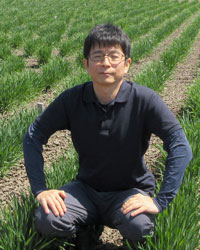The main themes of the symposium will be:
1)Mechanisms of pre-harvest sprouting (PHS) and seed dormancy
2)Interaction of environment and PHS
3)Grain and food quality affected by PHS
4)New germplasm materials and methods for PHS tolerance breeding
Although this symposium’s title contains ‘in cereal ‘, we welcome presentations resulted from other species such as vegetables when PHS is a problem for their production.
| 9:00- | Registration desk open |
|---|---|
| 9:30-9:40 | Opening Remarks |
| 9:40 -10:20 | Selected topics on seed dormancy in Arabidopsis: the role of seed coat apoplastic barrier plasticity and of DOG1 in endospermic ABA release |
|---|
| 10:20-10:50 | Grain dormancy and grain moisture interact under cool maturation conditions to induce a transient period of elevated susceptibility to pre-harvest sprouting in wheat in Western Australia |
|---|---|
| 10:50-11:20 | Genetic mechanisms contributing to low falling number in U.S. wheat, preharvest sprouting and LMA |
| 11:20-11:50 | Involvement of Gibberellin Signaling Pathway in Regulation of Seed Dormancy and Germination in Rice |
| 13:40-14:20 | Wheat breeding in Hokkaido, northern part of Japan: Improvement of pre-harvest sprouting tolerance, yield, and food-processing quality |
|---|
| 14:20-14:50 | Pre-harvest sprouting and dormancy studies in Okayama University |
|---|---|
| 14:50-15:10 | Regulation of pre-harvest sprouting by targeted mutagenesis of grain dormancy genes in barley |
| 15:10-15:30 | Field cultivation trial of TaQsd1 genome-edited wheat |
| 15:50-16:10 | Improved balance of seed dormancy and malt modification |
|---|
| 16:10-16:40 | Breeding for Preharvest Sprouting (PHS) Tolerance in the South African Wheat (Triticum aestivum L.) Germplasm: current status and future prospects |
|---|
| 9:30-10:10 | Plant Breeding for a Sustainable Agriculture: current achievements and future challenges in cereals |
|---|
| 10:10-10:30 | Explore of differentially expressed genes in seeds with different dormancy in barley: Bioinformatic analysis using RNA-seq data |
|---|---|
| 10:30-11:00 | Proteomics of Barley for AI-aided research of PHS |
| 11:00-11:30 | Pre-harvest sprouting and post-harvest grain dormancy in barley: regulation by MKK3 transcription and enzyme activity |
| 13:30-14:00 | Progress towards climate-resilient and preharvest sprouting-resistant Norwegian spring wheat |
|---|---|
| 14:00-14:20 | Genetic mechanisms behind QTL for temperature-stable high dormancy level in the Norwegian spring wheat line T7347 |
| 14:20-14:50 | Genome-wide association study identifies a gene responsible for temperature-dependent rice germination |
| 14:50-15:20 | Fine-tune seed dormancy to achieve the balance of preharvest sprouting tolerance and seed dormancy in barley |
| 15:20-15:50 | Identification of QTLs and underlying Candidate Genes for Pre-harvest Sprouting Tolerance and Falling Number in Common Wheat |
| 16:00-16:50 | Core-time, Meeting Room No.2 |
|---|
| 10:00-10:20 | Introgression of dwarfing allele dwarf-1 from Yellow Milo reduced grain dormancy and increased pre-harvest sprouting susceptibility in sorghum converted lines |
|---|---|
| 10:20-10:40 | Attempt to alter the grain dormancy trait on synthetic hexaploids derived from interspecific crosses between durum and diploid species of Triticeae tribe |
| 10:40-11:00 | Functional analysis of DOG1-dependent ABA signaling cascade |
| 11:00-11:20 | Genetic improvement and application of pre-harvest sprouting resistance by wheat germplasm resources |
| 11:20-11:40 | Genetic variation of TaMyb10 that affects both seed color and germination of wheat |
| 11:40-11:55 | Introduction for next symposium |
| 11:55-12:05 | Summary and Closing remarks |
1)Does gamma-aminobutyric acid (GABA) affect seed dormancy?
Eiko Himi (Kibi International University, Japan)
2)RNA-seq analysis of developing seeds in a wheat mutant RSD32 with reduced seed dormancy
Kazuhide Rikiishi (IPSR, Okayama University, Japan)
3)Correlation Analysis between Pre-harvest sprouting Resistance and Seed Dormancy in Wheat
Ling Chen (Institute of food crops, Hubei academy of agriculture sciences, China)
4)Conserved cis-acting motifs and localization of transcripts and proteins of MFT2 from barley and rice
Shigeko Utsugi (IPSR, Okayama University, Japan)
1)QTL mapping of pre-harvest sprouting related traits in bread wheat population SHA3/CBRD x Naxos confirms a negative
effect of the 1B/1R translocation on falling number
Morten Lillemo (Norwegian University of Life Sciences, Norway)
2)Genome-wide association mapping of pre-harvest sprouting resistance in Nordic spring wheat
Morten Lillemo (Norwegian University of Life Sciences, Norway)
3)Evaluation of pre-harvest sprouting tolerance and malt quality in malting barley lines bred from ‘N68-411’ and grown in
Canada
Rina Makimoto (Sapporo Breweries Ltd., Japan)
4)Analysis of the genomic region associated with pre-harvest sprouting tolerance identified in gamma-ray irradiated
wheat mutant
Shoya Komura (Kyoto University, Japan)
5)Pre-breeding for preharvest sprouting resistance in Nordic spring wheat
Ronja Wonneberger, Therese Bengtsson (Swedish University of Agricultural Sciences, Sweden)
6)Identification of the MFT-3A genotype of the wheat germplasm in Taiwan
Yi-Syuan Chen, Wan-Yi Chiou (National Chung Hsing University, Taiwan)

University of Geneva, Switzerland
Tentative presentation title: Interaction between environment and seed dormancy
Pre-harvest sprouting tolerance largely depends on seeds (grain) dormancy levels. It is well-known that there is strong interaction between environment and seed dormancy levels. For example, a wheat cultivar ‘Norin61’ shows a wide variety of germination percentages from 0% to 100% depends on temperature from 13°C to 25°C during grain development (Nakamura et al. 2011). Prof. Luis Lopez-Molina will talk about the latest research on interaction between environment and seed dormancy.

KWS SAAT SE & Co. KGaA, Germany
Presentation title: Plant breeding for a sustainable agriculture: Current achievements and future challenges in cereals
Dr. Viktor Korzun has been working for wheat and barley breeding for more than 30 years in KWS, one of the world leading breeding companies. He will talk about the latest breeding strategy and methods used in KWS, and how they effectively work to overcome various problems related to yield, disease and abiotic stress we face to support sustainable agriculture.

Kitami Agricultural Experiment Station, Hokkaido Research Organization
Presentation title: Wheat breeding in Hokkaido, Japan: Improvement of pre-harvest sprouting tolerance, yield, and food-processing quality
Hokkaido, in the northern part of Japan, is the largest producer of wheat in the country. Because of a lot of rain and low temperatures during wheat harvesting periods in the region, the breeding programs have been committed to improving pre-harvest sprouting (PHS) tolerance. Dr. Ohnishi will present the recent improvements on PHS tolerance, yield and food-processing quality of the wheat breeding group of the Hokkaido Research Organization.
Chengcai Chu (College of Agriculture, SCAU, China)
Chengdao Li (Murdoch University, Australia)
Jean-Philippe Ral (CSIRO, Australia)
Jirui Wang (Sichuan Agricultural University, China)
Jose Barrero (CSIRO, Australia)
Robert Benech-Arnold (University of Buenos Aires, Argentina)
Rodriguez Veronica (University of Buenos Aires, Argentina)
Shingo Nakamura (Institute of Crop Science, NARO, Japan)